Persepsi Diri dan Hubungan Teman Sebaya: Studi Korelasional di SMK Negeri 4 Kalabahi
Abstract
This study investigates the relationship between self-perception and peer association among vocational high school students at SMK Negeri 4 Kalabahi. Using a quantitative correlational research design, data were collected from 63 students selected through proportional stratified random sampling. Two Likert-scale questionnaires, measuring self-perception and peer association, were validated for content and reliability, achieving Cronbach’s alpha values of 0.820 and 0.899, respectively. Descriptive statistics revealed that 74.6% of participants exhibited high self-perception, and 65.1% reported high peer association. Normality and linearity assumptions were met, and Pearson’s product-moment correlation indicated a low but statistically significant positive relationship between self-perception and peer association (r = 0.275, p < 0.05). The findings suggest that students with higher self-perception are more likely to engage positively with peers, although the strength of the association is modest. These results highlight the multifactorial nature of adolescent social development, where self-perception interacts with environmental, social, and personal variables. The study emphasizes the need for educational interventions that foster positive self-perceptions and supportive peer environments, contributing to improved adolescent well-being and academic engagement.
Downloads
References
Azizah, S. A. N., & Hastuti, D. (2019). The Influence of Maternal Acceptance-Rejection and Adolescents Self Esteem to Bullying Behavior Junior High School Students. Journal of Family Sciences, 4(1), 12–25. https://doi.org/10.29244/jfs.4.1.12-25
Batool, S., & Shafiq, S. (2022). Self-Regulation as Mediator in Peer Relationship, Rejection Sensitivity With Positive Development Among Adolescents. Khyber Medical University Journal. https://doi.org/10.35845/kmuj.2022.20889
Bédard, K., Bouffard, T., & Pansu, P. (2014). The Risks for Adolescents of Negatively Biased Self‐evaluations of Social Competence: The Mediating Role of Social Support. Journal of Adolescence, 37(6), 787–798. https://doi.org/10.1016/j.adolescence.2014.05.004
Betts, L. R., Spenser, K. A., & Gardner, S. (2017). Adolescents’ Involvement in Cyber Bullying and Perceptions of School: The Importance of Perceived Peer Acceptance for Female Adolescents. Sex Roles, 77(7–8), 471–481. https://doi.org/10.1007/s11199-017-0742-2
Boele, S., Graaff, J. V. d., Wied, M. d., Valk, I. E. v. d., Crocetti, E., & Branje, S. (2019). Linking Parent–Child and Peer Relationship Quality to Empathy in Adolescence: A Multilevel Meta-Analysis. Journal of Youth and Adolescence, 48(6), 1033–1055. https://doi.org/10.1007/s10964-019-00993-5
Boulton, M. J., Smith, P. K., & Cowie, H. (2010). Short-Term Longitudinal Relationships Between Children’s Peer Victimization/Bullying Experiences and Self-Perceptions. School Psychology International, 31(3), 296–311. https://doi.org/10.1177/0143034310362329
Cardwell, S. M., Mazerolle, L., Piquero, A. R., & Luengen, K. (2021). Perceiving Teachers as Procedurally Just Limits the Negative Effects of Delinquent Peer Associations: An Analysis of Australian Adolescent Boys’ and Girls’ Perceptions of School Authority. Journal of Social Issues, 77(2), 547–576. https://doi.org/10.1111/josi.12447
Chu, C. M., Daffern, M., Thomas, S., Ang, Y., Long, M., & O’Brien, K. (2015). Determinants of Gang Affiliation in Singaporean Youth Offenders: Social and Familial Factors. Journal of Aggression Conflict and Peace Research, 7(1), 19–32. https://doi.org/10.1108/jacpr-11-2013-0031
Crone, E. A., & Fuligni, A. J. (2020). Self and Others in Adolescence. Annual Review of Psychology, 71(1), 447–469. https://doi.org/10.1146/annurev-psych-010419-050937
Dapprich, A. L., Derks, L. M., Holtmann, M., Lange, W., Legenbauer, T., & Becker, E. S. (2023). Hostile and Threatening Interpretation Biases in Adolescent Inpatients Are Specific to Callous-Unemotional Traits and Social Anxiety. European Child & Adolescent Psychiatry, 33(4), 1143–1150. https://doi.org/10.1007/s00787-023-02227-3
DEMİRCİ, Z. A., Bıçakçı, M. Y., & Uysal, B. (2022). Investigation of the Effect of Social Emotional Learning on Peer Relationships of Adolescents. Journal of Education and Future, 21, 1–13. https://doi.org/10.30786/jef.789061
DeWalt, D. A., Thissen, D., Stucky, B. D., Langer, M. M., DeWitt, E. M., Irwin, D. E., Lai, J., Yeatts, K., Gross, H. E., Taylor, O., & Varni, J. W. (2013). PROMIS Pediatric Peer Relationships Scale: Development of a Peer Relationships Item Bank as Part of Social Health Measurement. Health Psychology, 32(10), 1093–1103. https://doi.org/10.1037/a0032670
Doğan, R. Y., & Demircioğlu, H. (2024). The Role of Bullying Perpetration and Victimization in Adolescents’ Perceptions of School Climate and Social Media Usage. Psychology in the Schools, 62(2), 416–436. https://doi.org/10.1002/pits.23330
EREZ, S., & AĞIRKAN, M. (2024). A Model for Explaining Digital Addiction in Adolescents: The Role of Self-Perception, Social-Emotional Learning, Adolescent-Parent Relationship and Peer Relationships. Bağımlılık Dergisi, 25(2), 180–190. https://doi.org/10.51982/bagimli.1362217
Esteban‐Burgos, A. A., Fernández‐Alcántara, M., Escribano, S., Perpiñá‐Galvañ, J., Campos-Calderón, C. P., & Cabañero‐Martínez, M. J. (2022). Psychometric Properties of the Spanish Version of the Fatigue Assessment Scale in Caregivers of Palliative Care Patients. Journal of Clinical Medicine, 11(14), 3999. https://doi.org/10.3390/jcm11143999
Fernández-Rouco, N., Fernández‐Fuertes, A. A., Lastra, M. G., & España-Chico, C. (2022). School-Based Mentoring in Secondary Education: Its Effect on School Climate and Aggression Among Peers. Canadian Journal of School Psychology, 37(4), 328–343. https://doi.org/10.1177/08295735221127059
Fuentes, M. del C. P., Jurado, M. del M. M., Linares, J. J. G., Ruíz, N. F. O., Márquez, M. del M. S., & Saracostti, M. (2019). Parenting Practices, Life Satisfaction, and the Role of Self-Esteem in Adolescents. International Journal of Environmental Research and Public Health, 16(20), 4045. https://doi.org/10.3390/ijerph16204045
Gage, N. A., Kramer, D. A., & Ellis, K. (2020). High School Students With Emotional and Behavioral Disorders Perceptions of School Climate. Journal of Disability Policy Studies, 32(2), 83–94. https://doi.org/10.1177/1044207320934800
Gallardo, L. O., & Barrasa, Á. (2016). Analysis of the Changing Relationship Between Peer Acceptance and Academic Achievement in Adolescents / Análisis De La Relación Variable Entre La Aceptación Entre Iguales Y El Rendimiento Académico De Los Adolescentes. International Journal of Social Psychology Revista De Psicología Social, 31(3), 589–608. https://doi.org/10.1080/02134748.2016.1190128
Giovazolias, T. (2023). The Relationship of Rejection Sensitivity to Depressive Symptoms in Adolescence: The Indirect Effect of Perceived Social Acceptance by Peers. Behavioral Sciences, 14(1), 10. https://doi.org/10.3390/bs14010010
Go’o, A. A., Geradus, U., & Indrawan, P. A. (2023). Hubungan Keaktifan Organisasi Dengan Rasa Percaya Diri Pada Mahasiswa. Jurnal Bimbingan Konseling Flobamora, 1(3). https://doi.org/10.35508/jbkf.v1i3.11183
Hashimoto, S., Onuoha, F. N., Isaka, M., & Higuchi, N. (2011). The Effect of Adolescents’ Image of Parents on Children’s Self-Image and Mental Health. Child and Adolescent Mental Health, 16(4), 186–192. https://doi.org/10.1111/j.1475-3588.2011.00596.x
He, J., & Liu, H. (2025). Interest-Curiosity, Depression, and Peer Relationships Among Chinese Adolescents: A Cross-Lagged, Semi-Longitudinal Study. Psychology Research and Behavior Management, Volume 18, 449–460. https://doi.org/10.2147/prbm.s499158
Inchley, J., Kirby, J., & Currie, C. (2011). Longitudinal Changes in Physical Self-Perceptions and Associations With Physical Activity During Adolescence. Pediatric Exercise Science, 23(2), 237–249. https://doi.org/10.1123/pes.23.2.237
Karyati, K. (2023). Environmentally Responsible Behavior of High School Students in Terms of the Ability to Solve Environmental Problems. Al Kawnu: SLWJ, 2(1). https://doi.org/10.18592/ak.v2i1.7430
Kavrama, F. U., & Gi̇zi̇r, S. (2017). School Belonging of Adolescents: The Role of Teacher–Student Relationships, Peer Relationships and Family Involvement. Educational Sciences Theory & Practice. https://doi.org/10.12738/estp.2017.1.0104
King, K. R., Reschly, A. L., & Appleton, J. J. (2012). An Examination of the Validity of the Behavioral and Emotional Screening System in a Rural Elementary School. Journal of Psychoeducational Assessment, 30(6), 527–538. https://doi.org/10.1177/0734282912440673
Kokkinos, C. M., & Hatzinikolaou, S. (2010). Individual and Contextual Parameters Associated With Adolescents’ Domain Specific Self‐perceptions. Journal of Adolescence, 34(2), 349–360. https://doi.org/10.1016/j.adolescence.2010.04.003
L., P. V, Andrews, J. J. W., & Nordstokke, D. (2020). Peer Victimization and Anxiety in Youth: A Moderated Mediation of Peer Perceptions and Social Self-Efficacy. Canadian Journal of School Psychology, 36(1), 9–22. https://doi.org/10.1177/0829573520951041
Liu, F., Chui, H., & Chung, M. C. (2020). The Effect of Parent–adolescent Relationship Quality on Deviant Peer Affiliation: The Mediating Role of Self-Control and Friendship Quality. Journal of Social and Personal Relationships, 37(10–11), 2714–2736. https://doi.org/10.1177/0265407520937358
Liu, X., Wang, L., & Liao, J. (2016). Enabling Delay of Gratification Behavior in Those Not So Predisposed: The Moderating Role of Social Support. Frontiers in Psychology, 7. https://doi.org/10.3389/fpsyg.2016.00366
Maenhout, L., Peuters, C., Cardon, G., Compernolle, S., Crombez, G., & DeSmet, A. (2020). The Association of Healthy Lifestyle Behaviors With Mental Health Indicators Among Adolescents of Different Family Affluence in Belgium. BMC Public Health, 20(1). https://doi.org/10.1186/s12889-020-09102-9
McBride, D., LeVasseur, S. A., & Li, D. (2013). Development and Validation of a Web-Based Survey on the Use of Personal Communication Devices by Hospital Registered Nurses: Pilot Study. Jmir Research Protocols, 2(2), e50. https://doi.org/10.2196/resprot.2774
Mikami, A. Y., Schad, M. M., Teachman, B. A., Chango, J. M., & Allen, J. P. (2015). Implicit Versus Explicit Rejection Self-Perceptions and Adolescents’ Interpersonal Functioning. Personality and Individual Differences, 86, 390–393. https://doi.org/10.1016/j.paid.2015.06.051
Moore, S. S., Stephens, A. M., & Kelly, P. J. (2022). Nurse Mentorship to Support Healthy Growth of Adolescent Girls. Journal of Psychosocial Nursing and Mental Health Services, 60(5), 15–18. https://doi.org/10.3928/02793695-20220324-03
Mueller, A. S. (2015). The Role of School Contexts in Adolescents’ Weight‐loss Behaviors and Self‐perceptions of Overweight. Sociological Inquiry, 85(4), 532–555. https://doi.org/10.1111/soin.12091
Newland, L. A., Giger, J. T., Lawler, M. J., Roh, S., Brockevelt, B. L., & Schweinle, A. (2018). Multilevel Analysis of Child and Adolescent Subjective Well‐Being Across 14 Countries: Child‐ and Country‐Level Predictors. Child Development, 90(2), 395–413. https://doi.org/10.1111/cdev.13134
Shen, Y., Zhou, Y., Ren, S., Li, Y., Li, Y., Zhou, R., Fan, X., & Xie, G. (2025). Relations Between Peer Bullying and Adolescent Depression: The Mediating Effect of Cellphone Usage. Frontiers in Psychiatry, 16. https://doi.org/10.3389/fpsyt.2025.1486628
Shikuku, D. N., Mohammed, H., Mwanzia, L., Ladur, A. N., Nandikove, P., Uyara, A., Waigwe, C., Nyaga, L., Bashir, I., Ndirangu, E., Bedwell, C., Bar‐Zeev, S., & Ameh, C. (2024). Evaluation of the Feasibility of a Midwifery Educator Continuous Professional Development (CPD) Programme in Kenya and Nigeria: A Mixed Methods Study. BMC Medical Education, 24(1). https://doi.org/10.1186/s12909-024-05524-w
Smink, F. R. E., Hoeken, D. v., Dijkstra, J. K., Deen, M., Oldehinkel, A. J., & Hoek, H. W. (2018). Self‐esteem and Peer‐perceived Social Status in Early Adolescence and Prediction of Eating Pathology in Young Adulthood. International Journal of Eating Disorders, 51(8), 852–862. https://doi.org/10.1002/eat.22875
Välimäki, M., Kurki, M., Hätönen, H., Koivunen, M., Selander, M., Saarijãrvi, S., & Anttila, M. (2012). Developing an Internet-Based Support System for Adolescents With Depression. Jmir Research Protocols, 1(2), e22. https://doi.org/10.2196/resprot.2263
Walters, J., Farley, J. P., Deater‐Deckard, K., & Kim‐Spoon, J. (2019). Predictors of Sibling Victimization and Associations With Self-Perception and Relationship Attachment in Adolescence. The Journal of Early Adolescence, 40(3), 305–327. https://doi.org/10.1177/0272431619837382
Whitney‐Snel, K., Valdez, C. E., & Totaan, J. (2020). “We Break the Cycle…”: Motivations for Prosocial Advocacy Among Former Gang Members to End Gang Involvement. Journal of Community Psychology, 48(6), 1929–1941. https://doi.org/10.1002/jcop.22390
Zashikhina, A., & Hägglöf, B. (2014). Self-Esteem in Adolescents With Chronic Physical Illness vs. Controls in Northern Russia. International Journal of Adolescent Medicine and Health, 26(2), 275–281. https://doi.org/10.1515/ijamh-2013-0507
Zheng, X., Chen, J., Yu, Q., Xiong, Q., Zhang, L., Li, C., & Shuping, S. (2023). Associations Between Peer Victimization and Problematic Internet Use Among Adolescents: Humor Makes a Difference. Journal of Interpersonal Violence, 38(13–14), 7911–7940. https://doi.org/10.1177/08862605221150463
Zorbaz, S. D., & Ergene, T. (2019). School Adjustment of First-Grade Primary School Students: Effects of Family Involvement, Externalizing Behavior, Teacher and Peer Relations. Children and Youth Services Review, 101, 307–316. https://doi.org/10.1016/j.childyouth.2019.04.019
Copyright (c) 2025 Angela Alisia Wahon, M D Pua Upa, Putu Agus Indrawan

This work is licensed under a Creative Commons Attribution 4.0 International License.

 Angela Alisia Wahon(1*)
Angela Alisia Wahon(1*)




.png)

_copy1.jpg)


